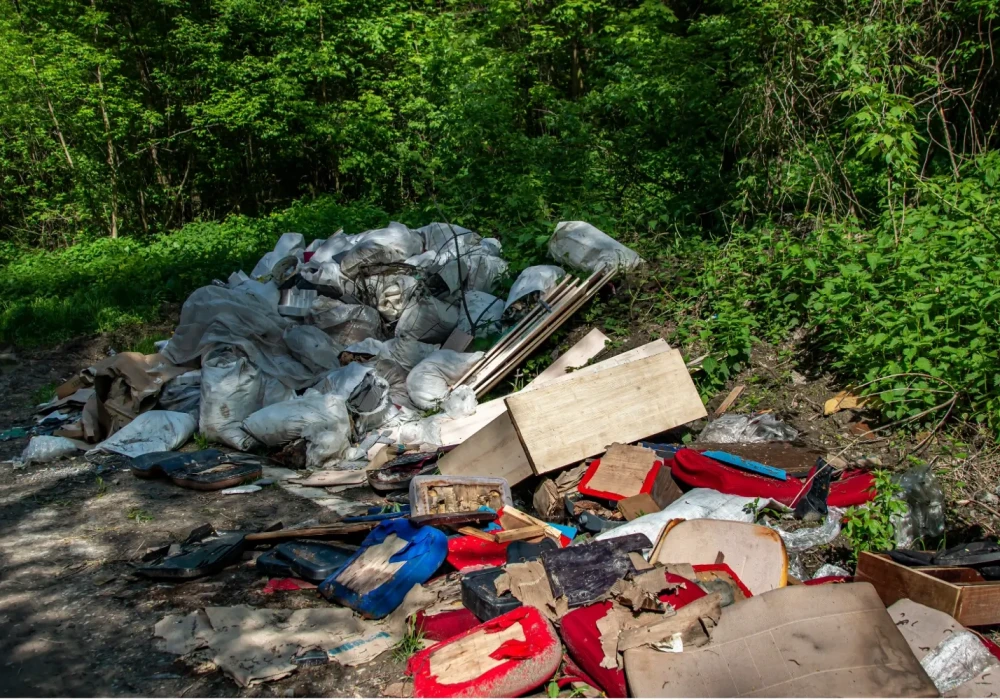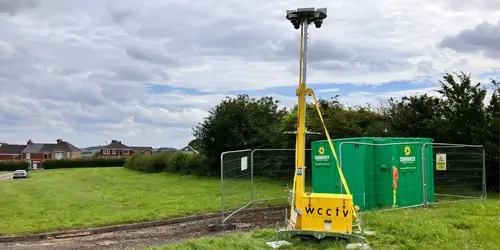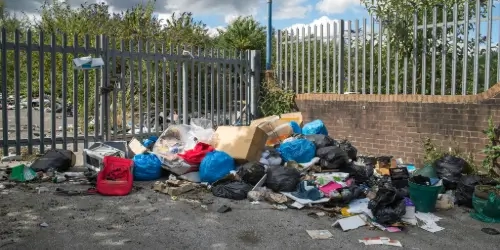With bin strikes continuing across Birmingham, the rise in rubbish has not been the only issue Local Authorities have been faced with. Unfortunately, it’s created the ideal opportunity for individuals to mask their fly-tipping.
Although this is not a nationwide issue as of yet, many Local Authorities will likely be concerned of the damage this type of incident has on the already overwhelming issue of fly-tipping for most areas across the UK.
We explore more on the bin strikes, fly-tipping issues presented through this and how to prevent fly-tipping in general.
What Are Bin Strikes?
So, what are bin strikes?
Similar to train strikes, recently Birmingham Council and their refuse workers have been in disputes over pay which has led to a strike.
Strikes are when employees stop working completely or significantly reduce their hours as part of industrial action. This could be due to various reasons, whether that be related to pay, hours, or overtime.
In this instance with Birmingham, refuse workers implemented the strike over pay and their response has been an all-out strike against waste disposal, leaving piles of rubbish building up outside of homes, schools, and shops.
This ongoing incident in Birmingham has shone a light on a potential risk other Local Authorities and Councils may face in future, but also the increased risk of fly-tipping that is likely alongside this.
How Do Bin Strikes Impact Fly-Tipping?
Bin strikes alone are dangerous, but as waste grows so does the risk of fly-tipping. There’s various reasons for this and these are as follows:
Fly-Tippers Masking Illegal Waste Disposal Into Bin Strikes
The main risk associated between bin strikes and fly-tipping is the opportunity it provides to individuals to illegally dump waste and mask it as part of household waste that is already present on the streets.
From old white goods like fridges and freezers to broken furniture, fly-tippers are essentially placing illegal waste alongside bin bags or masking it underneath rubbish.
Generally, fly-tipping will take place in rural and remote locations after dark in order for those involved to keep their identity concealed. However, with bin strikes, fly-tippers can be more brazen with their actions.
This will likely lead to an increase in fly-tipping, placing an even bigger financial burden on Local Authorities and Councils.
Increased Risk of Low Cost Illegal Removal Companies
Bin strikes can escalate quickly, leading to some homes, shops and businesses becoming overwhelmed by bin bags.
Due to this, some individuals will take great action to remove their waste, especially through companies promising cheap prices. However, these cheap prices do not mean that waste will be removed correctly.
Some individuals and illegitimate companies will take advantage of the bin strikes to profit for themselves.
They’ll tell homeowners and businesses that they’ll dispose of their waste legitimately but at a lower rate. But, in reality they will simply fly-tip it elsewhere.
A Rise in Incorrect Waste Disposal Methods
As well as illegitimate companies and individuals charging home and business owners to remove waste on their behalf, individuals will also do this on their own accord.
This could simply be in protest to striking or not being able to afford the removal costs of larger goods such as fridges, freezers and furniture.
Potential fly-tippers could see an opportunity to commit their crimes and remain under the radar whilst Local Authorities point their focus to the bin strikes. This can create difficulty in prosecuting individuals involved as the longer fly-tipping goes unknown, the less likely you’ll be able to find the culprits.
With fly-tipping already at record highs, bin strikes only threaten to increase incident numbers and reduce the chances of finding those responsible.
Negative Consequences of Fly-Tipping
With bin strikes only likely to increase fly-tipping, Local Authorities are faced with many concerns as fly-tipping can cause a number of negative consequences.
Damage to Environment and Wildlife
Fly-tipping can be extremely damaging to the environment, from polluting surrounding soil and water to harming wildlife and creating ecosystem disruption.
In the worst case scenario, fly-tipping can cause disease transmission and severe public safety risks which could create harm to residents and visitors in the local area.
Fly-tipped waste can contain hazardous materials like chemicals, asbestos and plastic, all of which can have a long-term impact on the environment. They can corrode, damage and even pose risks to human health.
This material can also be ingested by wildlife, whether it be poisoning them through toxic chemicals or entangling themselves in plastic. Essentially, it can destroy the natural habitat and disrupt ecosystems which are difficult to recover from.
Public Safety Risks
One issue most individuals will be unaware of with fly-tipping is that items being illegally dumped could include dangerous materials or chemicals.
These materials may pose a significant risk to the public due to several reasons:
- Hazardous materials like syringes, glass, asbestos and chemicals which could cause physical harm if ingested or handled.
- Fly-tipping can attract vermin which can spread diseases and create unsanitary conditions within those locations.
- Create physical barriers and obstructions on roads, pavements and public spaces which can create operational disruption and accidents within the area.
- For many Local Authorities, they pride themselves on their local area and its cleanliness and fly-tipping tends to threaten that, creating visual pollution for residents and visitors.
Local authorities are responsible for those within their area and provide a duty of care to them, therefore any risk to public safety must be dealt with, making fly-tipping an urgent threat for them.
Financial Loss
The biggest challenge faced by Local Authorities regarding fly-tipping is the financial loss that is caused from clean-up fees.
This issue affects all Local Authorities, with the most recent statistics stating that cost of clearance amounted to £13.1 million across England.
With figures only increasing every year, it can only be expected that the financial loss created from this will increase, especially in vulnerable times like bin strikes where the crime is easier to commit.
Local Authorities’ budgets are already stretched, so further financial burdens such as this will only lead to other key services facing cuts to cover the clean-up of this damaging crime.
Top 7 Tips For Local Authorities on Tackling Fly-Tipping
Fly-tipping is a nationwide issue that is becoming overwhelming for nearly all Local Authorities to manage.Therefore in cases where areas are more prone to these risks like bin strikes, Local Authorities need to be aware of the security measures you can put in place to prevent fly-tipping in your area.
Using our 20-years of security solutions expertise, we formed 7 top tips Local Authorities can deploy to help prevent fly-tipping:
Install Mobile CCTV at Fly-Tipping Hotspots
Often considered the most effective security method for fly-tipping, specifically in public spaces, mobile CCTV offers effective fly-tipping prevention via both overt and covert options..
For urban locations, you can utilise cameras like our Redeployable CCTV Cameras. These can be mounted onto poles in hotspot areas, allowing you to remain on watch even in those narrow locations.
For rural and layby locations, our CCTV Towers provide both a visible deterrent and a live monitoring and recording security system in one. This maximises the protection a fly-tipping hotspot receives as these locations are most common targets.
Both options can be moved to other locations, providing a flexible, complete power autonomous security service and cellular connectivity.
This means in cases like the bin strikes, WCCTV are able to move the Redeployable Camera or CCTV Tower to a newly identified hotspot with minimal operational disruption.
With some Public Sector tenders you can also apply for funding to utilise security systems as preventative measures against fly-tipping.
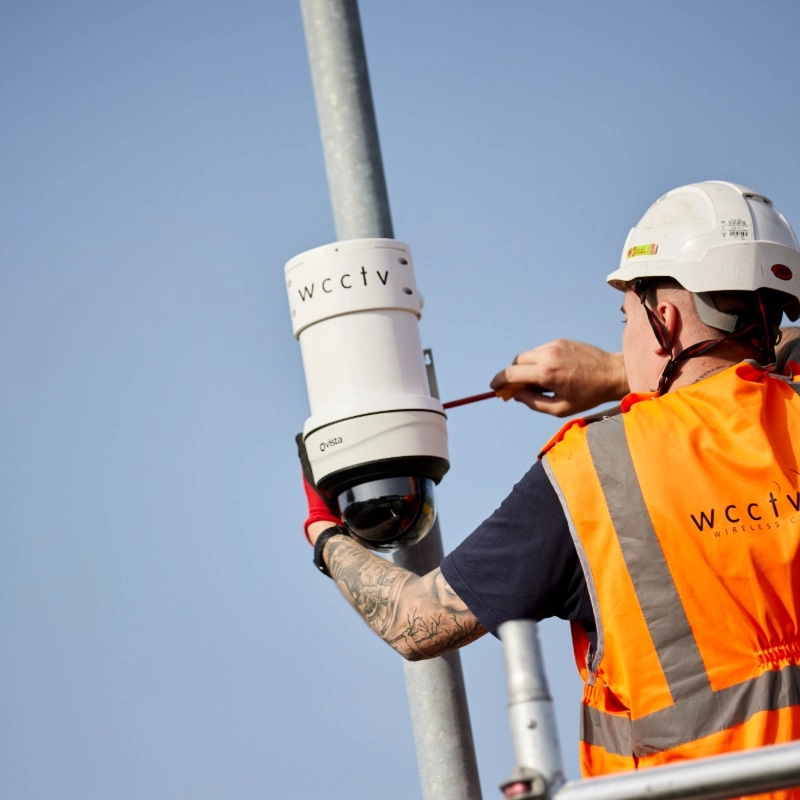
Engage With the Local Community Through Fly-Tipping Focused Campaigns
That’s why community engagement is important to help educate those who may be unaware of the law and the consequences that can be faced by an individual for breaking them.
For the best engagement, you need to plan in advance with your campaign on the best communication methods, key messages and the target audience.
Most successful campaigns will utilise various communication methods in order to reach as many individuals from the community and surrounding local area.
You should also consider how you will communicate your fly-tipping messages to visitors as there are likely to be external individuals who look to use your area as an illegal dumping ground.
Campaigns are particularly beneficial for targeting a specific focus. Therefore, in cases like the bin strikes, you can create themed campaigns that engage with that sole issue and how the community should respond.
Promote Disposal Options and Fly-Tipping Reporting Processes
You’ll be surprised how many individuals are unaware of the official disposal options available to them in cases of additional waste disposal being required or to help remove large items.
Without this information, individuals will look to dispose of waste and goods through illegal avenues, therefore increasing the risk of fly-tipping.
Especially in periods of high tension like the bin strikes, individuals may feel more encouraged to engage in this activity, hence the need to communicate the disposal options available in their local area.
You can communicate these options via social media, noticeboards, community groups and town meetings, depending on what is most suitable for your community.
Make sure that all options are explained clearly, including key information such as the cost, waste type accepted, location and disposal process.
Ensure Fly-Tipping Hotspots are Well-Lit
This may seem simple, but darkness provides fly-tippers with the perfect opportunity to illegally dump their waste without Local Authorities finding out.
This is only heightened with the bin strikes as this waste can be masked into the already piled up bin bags on the streets.
Most Local Authorities will be aware of fly-tipping hotspots in their area, however, if you are unsure it’s best to review previous data and establish the areas with the highest number of incidents.
Once established, you should explore your lighting options for the hotspot. Each area will vary in its requirement, so what one area may suit, for another it may not be the correct sizing or provide enough lighting strength.
You should implement lighting at any fly-tipping hotspot and ensure this covers the location site 24/7, in particular at night when fly-tipping is more likely to take place.
It helps to make any perpetrators’ identities visible in case of witnesses and is a crime deterrent for any individuals considering fly-tipping.
Restrict Access to Rural Spaces Where Fly-Tipping is More Common
For some fly-tipping hotspots, you may be able to restrict their access through natural or physical barriers, stopping any fly-tippers from dumping their waste illegally.
Although this may not be suitable in areas like laybys where it would be both dangerous and impractical to restrict their access, other, more rural areas could benefit from this.
You could use natural barriers such as logs, rocks and branches to prevent access, or if you wish to enhance this further, you could deploy fencing to create a higher barrier.
This does not guarantee protection from fly-tipping, but it strengthens the area from being targeted.
Place Strong Visible Deterrents in Laybys
Protecting laybys can be more difficult because of their open access to road users and reduced visibility.
In these instances you should aim to place strong, visible criminal deterrents at each location to inform any potential fly-tippers they’re being watched.
Our CCTV Tower range works as both a visible deterrent and as a live monitoring and recording device to help prevent and capture fly-tippers,so you remain protected at all stages.
Standing up to 6 metres in height and painted bright yellow, their security presence cannot be mistaken and if any fly-tippers continue to illegally dispose of their waste at the layby, our security system will implement further prevention tools and provide live video recording for evidence.
Visible deterrents will support crime deterrence, but without the back-up, your laybys will continue to remain targets as you’ll have no evidence to prosecute.
Ensure any Security Systems are Backed by Remote Monitoring Services
Recording live events is beneficial for evidential purposes, however, what if you had the eyes of trained professionals monitoring to help actively deter crime? Well, it would make security much simpler for your Local Authority.
All of our products, from the Redeployable CCTV Cameras to our CCTV Towers are backed by NSI Gold Accredited Security remote monitoring stations that detect, deter and defend against fly-tipping.
They will monitor live footage to assess threats, respond appropriately and when needed, contact the Police to help both prevent and capture criminals.
Working retrospectively on crime like fly-tipping will likely heavily reduce the chances of prosecution and regaining the financial loss caused from this. Therefore, active interception is the best form of response.
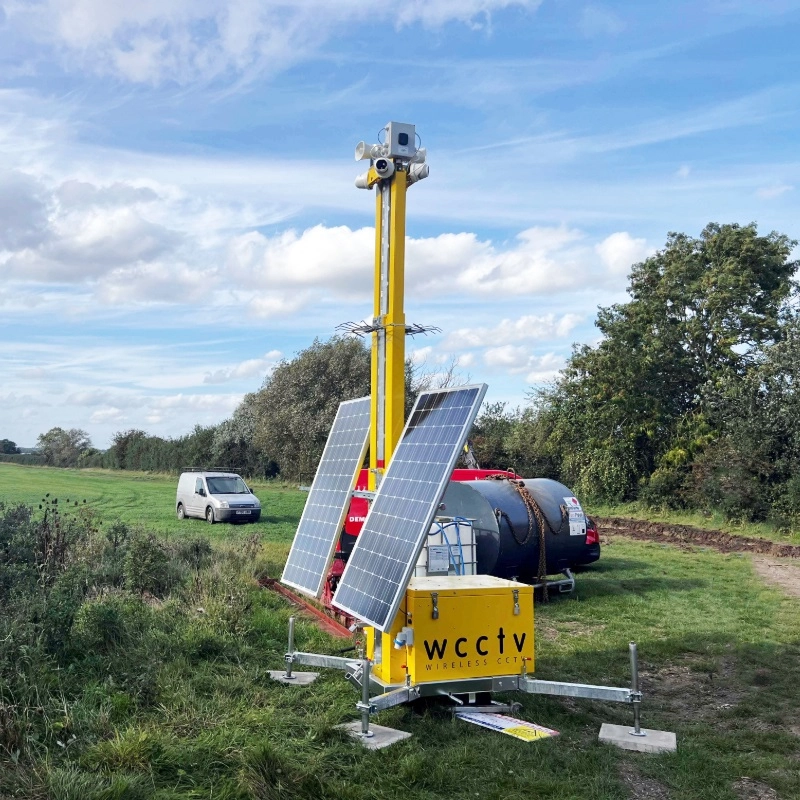
WCCTV: Market-Leading Security Solutions for Fly-Tipping Prevention
WCCTV have supported various Local Authorities with their fly-tipping prevention programmes and have successfully helped reduce the number of incidents in their local area.
Wiltshire Council - Littering and Fly-Tipping Prevention Use Case
As part of a litter clean-up campaign (Don’t Mess with Wiltshire), Wiltshire Council were looking to increase the surveillance of hot spot locations where fly-tipping and illegal waste removal were taking place.
Following some extra investment allocated to support litter enforcement, the Council wanted to help maintain the beauty of the areas, particularly focusing on layby locations, which were most popular for this type of crime.
When deciding the locations, Cllr Dominic Muns, Cabinet Member for Waste and Environment, said: “Laybys are often litter hotspots, where thoughtless and careless people throw rubbish from vehicles, damaging the environment and generally making Wiltshire a less pleasant place.”
Wiltshire Council invested in three of our mobile CCTV Towers which were installed across three laybys labelled as littering hotspots to help prevent, catch and change the future behaviours of offenders.
Following their successful deployment, Cllr Nick Holder, Cabinet Member for Highways and Street Scene, said: “The number of fly-tips in Wiltshire has been on a downward trend over the course of last year. We've also seen a 31% increase in fly-tipping prosecutions year on year. We are taking all the legal options available to us wherever we find fly-tipping, giving a clear warning that illegal waste disposal is not tolerated, and offenders will face serious consequences.”
Whatever your needs, whether it be an urban or rural environment, we can support you in securing your public spaces and futureproofing your community from fly-tipping.
